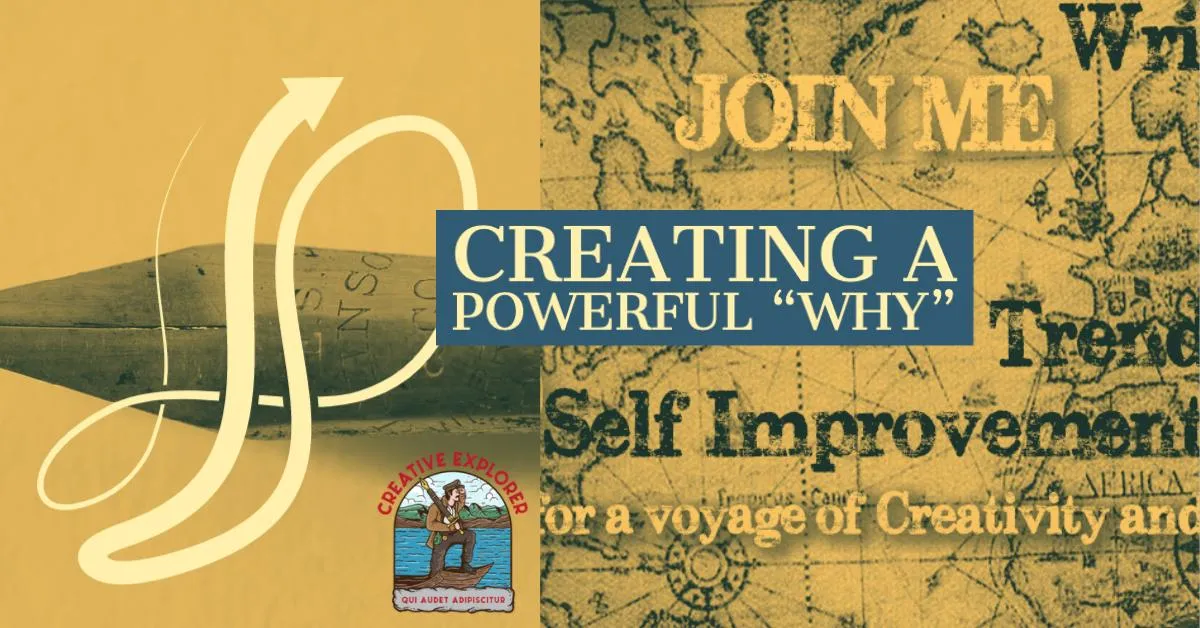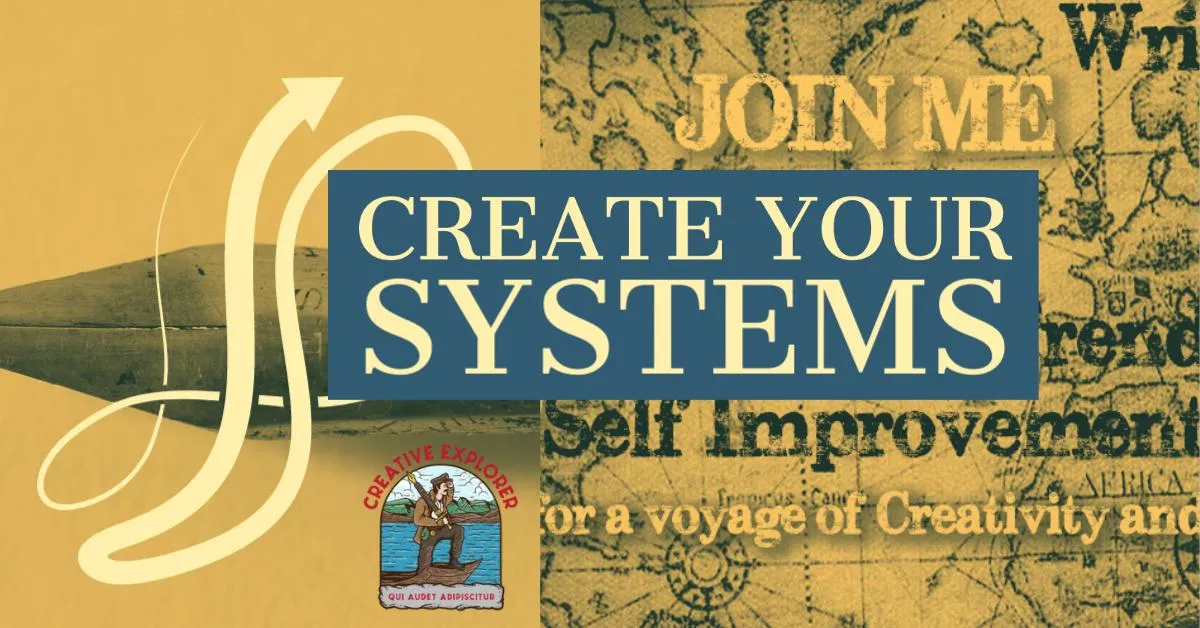"The Society that separates its Scholars from its Warriors, will have its thinking done by cowards and its fighting done by fools." Thucydides

PURPOSE: Become the Scholar Warrior for your Goals
Improve Every Single Day!
Improve Yourself 1% a Day = 3600%+ in a Year
Thought-Technique-Strategy of the Week:

Create Your Powerful Identity
Let's say you wish to excel in the art of painting. Or open your own woodworking business. Or become a Filmmaker which I did many years ago. The key is to utilize a Powerful Identity in reframing your Focus. Let's stick with painter for the moment.
Use the words: "I am a painter." The powerful use of the "I am..." phrase welds this new outlook to you mentally, intellectually but, more importantly, emotionally. Why emotionally? When you talk about painting (or any very exciting goal), then you can feel the electrical excitement within your body and Being.
"Being" is the act of existing within this newly embraced identity. Then you grow and become.
READ THE MAIN ARTICLE HERE
7 Actions To Change Your Life
Michael's Kenpo Karate Weapons Form - Knife & Pistol
You can see my Pistol & Knife form at approximately 10:31 here in the video from 2010. This is at Bryan Hawkins Kenpo Karate where I have studied Kenpo Karate for approximately over 35 years. The form is one that I created to advance in the system, utilizing Kenpo Karate principles. I use the form with the primary weapon as the firearm, duly guarded and using the knife for close-in drills. This is the training the Warrior phase!




Create Your Own Systems: A Checklist
“Systems” are used in our daily lives in almost every facet. Consider the following systems you probably take for granted for running a few simple errands
Traffic System - from staying in your line, speed, getting tickets (ugh!) and more
Credit Card System - making your payments today and tomorrow
Economic System - money - dollars, Euros, yen, gold, silver and more
To Do List System - your list could be geographical or chronological
Scheduling System - figuring out the times for events and appointments
Inventory System - when you go to each lunch, the restaurant stocks up.
Employment System - employees and employers
We covered systems in a previous article.
Use the Power of Systems
By creating a few systems of your own, you could improve your odds in numerous areas of your life such as:
Teaching Your Kids
Organizing Your Work Inquiries
Raising Money
Finding Work
Pursuing Your Dream
Here’s the key: Take YOUR system creation seriously. If you got paid to create a written system at work, you’d have to do the work. Well, you are going to get paid - emotionally, monetarily, etc., - by pursuing and achieving a major goal or dream.
So use the power of Systems for yourself!

A System Checklist
Here is a very good checklist to consider in Creating Your Own System. Pick and Choose. Don't let it overwhelm you.
But I am giving you the major checklist here so you can use what is useful but will know about all the attributes of a system. You might choose to incorporate them later.
When creating a simple method for a process, there are several points that you should consider. Here are some key ones:
Define the process: Before you start creating a method, make sure you understand the process you want to describe. This will help you to identify the key steps and potential pitfalls that you need to cover in your method.
Determine the scope: Decide on the scope of your method. Will it cover the entire process, or just a specific aspect of it? Be clear about what your method aims to achieve and what it won't cover.
Keep it simple: The goal of a simple method is to make it easy for anyone to follow. Use clear and concise language, and avoid unnecessary technical jargon.
Use a step-by-step approach: Break the process down into clear and logical steps. List the steps in the order they need to be completed and make sure that each step is clearly explained.
Highlight key points: Identify any critical steps, decision points, or potential challenges in the process. Be sure to highlight these in your method so that the user can be aware of them and take appropriate action.
Use visual aids: Diagrams, flowcharts, or other visual aids can help to make the process easier to understand. Consider including these in your method.
Test your method: Before finalizing your method, test it out to ensure that it is clear and easy to follow. Ask someone who is not familiar with the process to follow the method and provide feedback.
By considering these points, you can create a simple method that is easy to follow and effective in achieving its intended purpose.
TRY ONE! Create just one system for your Dream Goal and give it a month. With a good system, you will surprise yourself with your achievement.

Create Your Own Systems: A Checklist
“Systems” are used in our daily lives in almost every facet. Consider the following systems you probably take for granted for running a few simple errands
Traffic System - from staying in your line, speed, getting tickets (ugh!) and more
Credit Card System - making your payments today and tomorrow
Economic System - money - dollars, Euros, yen, gold, silver and more
To Do List System - your list could be geographical or chronological
Scheduling System - figuring out the times for events and appointments
Inventory System - when you go to each lunch, the restaurant stocks up.
Employment System - employees and employers
We covered systems in a previous article.
Use the Power of Systems
By creating a few systems of your own, you could improve your odds in numerous areas of your life such as:
Teaching Your Kids
Organizing Your Work Inquiries
Raising Money
Finding Work
Pursuing Your Dream
Here’s the key: Take YOUR system creation seriously. If you got paid to create a written system at work, you’d have to do the work. Well, you are going to get paid - emotionally, monetarily, etc., - by pursuing and achieving a major goal or dream.
So use the power of Systems for yourself!

A System Checklist
Here is a very good checklist to consider in Creating Your Own System. Pick and Choose. Don't let it overwhelm you.
But I am giving you the major checklist here so you can use what is useful but will know about all the attributes of a system. You might choose to incorporate them later.
When creating a simple method for a process, there are several points that you should consider. Here are some key ones:
Define the process: Before you start creating a method, make sure you understand the process you want to describe. This will help you to identify the key steps and potential pitfalls that you need to cover in your method.
Determine the scope: Decide on the scope of your method. Will it cover the entire process, or just a specific aspect of it? Be clear about what your method aims to achieve and what it won't cover.
Keep it simple: The goal of a simple method is to make it easy for anyone to follow. Use clear and concise language, and avoid unnecessary technical jargon.
Use a step-by-step approach: Break the process down into clear and logical steps. List the steps in the order they need to be completed and make sure that each step is clearly explained.
Highlight key points: Identify any critical steps, decision points, or potential challenges in the process. Be sure to highlight these in your method so that the user can be aware of them and take appropriate action.
Use visual aids: Diagrams, flowcharts, or other visual aids can help to make the process easier to understand. Consider including these in your method.
Test your method: Before finalizing your method, test it out to ensure that it is clear and easy to follow. Ask someone who is not familiar with the process to follow the method and provide feedback.
By considering these points, you can create a simple method that is easy to follow and effective in achieving its intended purpose.
TRY ONE! Create just one system for your Dream Goal and give it a month. With a good system, you will surprise yourself with your achievement.

Create Your Own Systems: A Checklist
“Systems” are used in our daily lives in almost every facet. Consider the following systems you probably take for granted for running a few simple errands
Traffic System - from staying in your line, speed, getting tickets (ugh!) and more
Credit Card System - making your payments today and tomorrow
Economic System - money - dollars, Euros, yen, gold, silver and more
To Do List System - your list could be geographical or chronological
Scheduling System - figuring out the times for events and appointments
Inventory System - when you go to each lunch, the restaurant stocks up.
Employment System - employees and employers
We covered systems in a previous article.
Use the Power of Systems
By creating a few systems of your own, you could improve your odds in numerous areas of your life such as:
Teaching Your Kids
Organizing Your Work Inquiries
Raising Money
Finding Work
Pursuing Your Dream
Here’s the key: Take YOUR system creation seriously. If you got paid to create a written system at work, you’d have to do the work. Well, you are going to get paid - emotionally, monetarily, etc., - by pursuing and achieving a major goal or dream.
So use the power of Systems for yourself!

A System Checklist
Here is a very good checklist to consider in Creating Your Own System. Pick and Choose. Don't let it overwhelm you.
But I am giving you the major checklist here so you can use what is useful but will know about all the attributes of a system. You might choose to incorporate them later.
When creating a simple method for a process, there are several points that you should consider. Here are some key ones:
Define the process: Before you start creating a method, make sure you understand the process you want to describe. This will help you to identify the key steps and potential pitfalls that you need to cover in your method.
Determine the scope: Decide on the scope of your method. Will it cover the entire process, or just a specific aspect of it? Be clear about what your method aims to achieve and what it won't cover.
Keep it simple: The goal of a simple method is to make it easy for anyone to follow. Use clear and concise language, and avoid unnecessary technical jargon.
Use a step-by-step approach: Break the process down into clear and logical steps. List the steps in the order they need to be completed and make sure that each step is clearly explained.
Highlight key points: Identify any critical steps, decision points, or potential challenges in the process. Be sure to highlight these in your method so that the user can be aware of them and take appropriate action.
Use visual aids: Diagrams, flowcharts, or other visual aids can help to make the process easier to understand. Consider including these in your method.
Test your method: Before finalizing your method, test it out to ensure that it is clear and easy to follow. Ask someone who is not familiar with the process to follow the method and provide feedback.
By considering these points, you can create a simple method that is easy to follow and effective in achieving its intended purpose.
TRY ONE! Create just one system for your Dream Goal and give it a month. With a good system, you will surprise yourself with your achievement.





Create Your Own Systems: A Checklist
“Systems” are used in our daily lives in almost every facet. Consider the following systems you probably take for granted for running a few simple errands
Traffic System - from staying in your line, speed, getting tickets (ugh!) and more
Credit Card System - making your payments today and tomorrow
Economic System - money - dollars, Euros, yen, gold, silver and more
To Do List System - your list could be geographical or chronological
Scheduling System - figuring out the times for events and appointments
Inventory System - when you go to each lunch, the restaurant stocks up.
Employment System - employees and employers
We covered systems in a previous article.
Use the Power of Systems
By creating a few systems of your own, you could improve your odds in numerous areas of your life such as:
Teaching Your Kids
Organizing Your Work Inquiries
Raising Money
Finding Work
Pursuing Your Dream
Here’s the key: Take YOUR system creation seriously. If you got paid to create a written system at work, you’d have to do the work. Well, you are going to get paid - emotionally, monetarily, etc., - by pursuing and achieving a major goal or dream.
So use the power of Systems for yourself!

A System Checklist
Here is a very good checklist to consider in Creating Your Own System. Pick and Choose. Don't let it overwhelm you.
But I am giving you the major checklist here so you can use what is useful but will know about all the attributes of a system. You might choose to incorporate them later.
When creating a simple method for a process, there are several points that you should consider. Here are some key ones:
Define the process: Before you start creating a method, make sure you understand the process you want to describe. This will help you to identify the key steps and potential pitfalls that you need to cover in your method.
Determine the scope: Decide on the scope of your method. Will it cover the entire process, or just a specific aspect of it? Be clear about what your method aims to achieve and what it won't cover.
Keep it simple: The goal of a simple method is to make it easy for anyone to follow. Use clear and concise language, and avoid unnecessary technical jargon.
Use a step-by-step approach: Break the process down into clear and logical steps. List the steps in the order they need to be completed and make sure that each step is clearly explained.
Highlight key points: Identify any critical steps, decision points, or potential challenges in the process. Be sure to highlight these in your method so that the user can be aware of them and take appropriate action.
Use visual aids: Diagrams, flowcharts, or other visual aids can help to make the process easier to understand. Consider including these in your method.
Test your method: Before finalizing your method, test it out to ensure that it is clear and easy to follow. Ask someone who is not familiar with the process to follow the method and provide feedback.
By considering these points, you can create a simple method that is easy to follow and effective in achieving its intended purpose.
TRY ONE! Create just one system for your Dream Goal and give it a month. With a good system, you will surprise yourself with your achievement.

Create Your Own Systems: A Checklist
“Systems” are used in our daily lives in almost every facet. Consider the following systems you probably take for granted for running a few simple errands
Traffic System - from staying in your line, speed, getting tickets (ugh!) and more
Credit Card System - making your payments today and tomorrow
Economic System - money - dollars, Euros, yen, gold, silver and more
To Do List System - your list could be geographical or chronological
Scheduling System - figuring out the times for events and appointments
Inventory System - when you go to each lunch, the restaurant stocks up.
Employment System - employees and employers
We covered systems in a previous article.
Use the Power of Systems
By creating a few systems of your own, you could improve your odds in numerous areas of your life such as:
Teaching Your Kids
Organizing Your Work Inquiries
Raising Money
Finding Work
Pursuing Your Dream
Here’s the key: Take YOUR system creation seriously. If you got paid to create a written system at work, you’d have to do the work. Well, you are going to get paid - emotionally, monetarily, etc., - by pursuing and achieving a major goal or dream.
So use the power of Systems for yourself!

A System Checklist
Here is a very good checklist to consider in Creating Your Own System. Pick and Choose. Don't let it overwhelm you.
But I am giving you the major checklist here so you can use what is useful but will know about all the attributes of a system. You might choose to incorporate them later.
When creating a simple method for a process, there are several points that you should consider. Here are some key ones:
Define the process: Before you start creating a method, make sure you understand the process you want to describe. This will help you to identify the key steps and potential pitfalls that you need to cover in your method.
Determine the scope: Decide on the scope of your method. Will it cover the entire process, or just a specific aspect of it? Be clear about what your method aims to achieve and what it won't cover.
Keep it simple: The goal of a simple method is to make it easy for anyone to follow. Use clear and concise language, and avoid unnecessary technical jargon.
Use a step-by-step approach: Break the process down into clear and logical steps. List the steps in the order they need to be completed and make sure that each step is clearly explained.
Highlight key points: Identify any critical steps, decision points, or potential challenges in the process. Be sure to highlight these in your method so that the user can be aware of them and take appropriate action.
Use visual aids: Diagrams, flowcharts, or other visual aids can help to make the process easier to understand. Consider including these in your method.
Test your method: Before finalizing your method, test it out to ensure that it is clear and easy to follow. Ask someone who is not familiar with the process to follow the method and provide feedback.
By considering these points, you can create a simple method that is easy to follow and effective in achieving its intended purpose.
TRY ONE! Create just one system for your Dream Goal and give it a month. With a good system, you will surprise yourself with your achievement.

Create Your Own Systems: A Checklist
“Systems” are used in our daily lives in almost every facet. Consider the following systems you probably take for granted for running a few simple errands
Traffic System - from staying in your line, speed, getting tickets (ugh!) and more
Credit Card System - making your payments today and tomorrow
Economic System - money - dollars, Euros, yen, gold, silver and more
To Do List System - your list could be geographical or chronological
Scheduling System - figuring out the times for events and appointments
Inventory System - when you go to each lunch, the restaurant stocks up.
Employment System - employees and employers
We covered systems in a previous article.
Use the Power of Systems
By creating a few systems of your own, you could improve your odds in numerous areas of your life such as:
Teaching Your Kids
Organizing Your Work Inquiries
Raising Money
Finding Work
Pursuing Your Dream
Here’s the key: Take YOUR system creation seriously. If you got paid to create a written system at work, you’d have to do the work. Well, you are going to get paid - emotionally, monetarily, etc., - by pursuing and achieving a major goal or dream.
So use the power of Systems for yourself!

A System Checklist
Here is a very good checklist to consider in Creating Your Own System. Pick and Choose. Don't let it overwhelm you.
But I am giving you the major checklist here so you can use what is useful but will know about all the attributes of a system. You might choose to incorporate them later.
When creating a simple method for a process, there are several points that you should consider. Here are some key ones:
Define the process: Before you start creating a method, make sure you understand the process you want to describe. This will help you to identify the key steps and potential pitfalls that you need to cover in your method.
Determine the scope: Decide on the scope of your method. Will it cover the entire process, or just a specific aspect of it? Be clear about what your method aims to achieve and what it won't cover.
Keep it simple: The goal of a simple method is to make it easy for anyone to follow. Use clear and concise language, and avoid unnecessary technical jargon.
Use a step-by-step approach: Break the process down into clear and logical steps. List the steps in the order they need to be completed and make sure that each step is clearly explained.
Highlight key points: Identify any critical steps, decision points, or potential challenges in the process. Be sure to highlight these in your method so that the user can be aware of them and take appropriate action.
Use visual aids: Diagrams, flowcharts, or other visual aids can help to make the process easier to understand. Consider including these in your method.
Test your method: Before finalizing your method, test it out to ensure that it is clear and easy to follow. Ask someone who is not familiar with the process to follow the method and provide feedback.
By considering these points, you can create a simple method that is easy to follow and effective in achieving its intended purpose.
TRY ONE! Create just one system for your Dream Goal and give it a month. With a good system, you will surprise yourself with your achievement.

Create Your Own Systems: A Checklist
“Systems” are used in our daily lives in almost every facet. Consider the following systems you probably take for granted for running a few simple errands
Traffic System - from staying in your line, speed, getting tickets (ugh!) and more
Credit Card System - making your payments today and tomorrow
Economic System - money - dollars, Euros, yen, gold, silver and more
To Do List System - your list could be geographical or chronological
Scheduling System - figuring out the times for events and appointments
Inventory System - when you go to each lunch, the restaurant stocks up.
Employment System - employees and employers
We covered systems in a previous article.
Use the Power of Systems
By creating a few systems of your own, you could improve your odds in numerous areas of your life such as:
Teaching Your Kids
Organizing Your Work Inquiries
Raising Money
Finding Work
Pursuing Your Dream
Here’s the key: Take YOUR system creation seriously. If you got paid to create a written system at work, you’d have to do the work. Well, you are going to get paid - emotionally, monetarily, etc., - by pursuing and achieving a major goal or dream.
So use the power of Systems for yourself!

A System Checklist
Here is a very good checklist to consider in Creating Your Own System. Pick and Choose. Don't let it overwhelm you.
But I am giving you the major checklist here so you can use what is useful but will know about all the attributes of a system. You might choose to incorporate them later.
When creating a simple method for a process, there are several points that you should consider. Here are some key ones:
Define the process: Before you start creating a method, make sure you understand the process you want to describe. This will help you to identify the key steps and potential pitfalls that you need to cover in your method.
Determine the scope: Decide on the scope of your method. Will it cover the entire process, or just a specific aspect of it? Be clear about what your method aims to achieve and what it won't cover.
Keep it simple: The goal of a simple method is to make it easy for anyone to follow. Use clear and concise language, and avoid unnecessary technical jargon.
Use a step-by-step approach: Break the process down into clear and logical steps. List the steps in the order they need to be completed and make sure that each step is clearly explained.
Highlight key points: Identify any critical steps, decision points, or potential challenges in the process. Be sure to highlight these in your method so that the user can be aware of them and take appropriate action.
Use visual aids: Diagrams, flowcharts, or other visual aids can help to make the process easier to understand. Consider including these in your method.
Test your method: Before finalizing your method, test it out to ensure that it is clear and easy to follow. Ask someone who is not familiar with the process to follow the method and provide feedback.
By considering these points, you can create a simple method that is easy to follow and effective in achieving its intended purpose.
TRY ONE! Create just one system for your Dream Goal and give it a month. With a good system, you will surprise yourself with your achievement.
Take Action Today!
SCHOLAR WARRIOR WAY - COURSES

Scholar Warrior Way
Take Action to Transform Yourself
By taking the Scholar Warrior Way Course, you will get Michael's program for Self-Improvement in his pursuit of Creative Excellence in Writing, Filmmaking, Martial arts and his other pursuits from his major curious outlook. Here are the 7 Steps that he uses....
Powerful Why - the Key to Enthusiasm and Fulfillment
Scholar Warrior Identity - Embracing the new Mentality - now!
Your Morning Routine - Starting the day Right.
Brainstorming Your How - Strategy thinking and tactics
Create Your Own Systems - Become efficient with predictable results
Building Transforming Habits - Habit creates Destiny
The Art of Sleep - Long ignored but a necessary health break.
Levels 1, 2 and 3 - Detailing and add more videos, wisdom, resources and Learning Materials for your Growth and Self-Improvement.
FAQS
What is The Purpose of the "ScholarWarriorWay" ?
By engaging in the mental perspective of the Scholar Warrior, you embrace two aspects of your life: The Scholar with a constant focus on self-development and self-improvement. The Warrior whereby you learn techniques about courage, action and derring-do to achieve your true authentic goals for a fulfilled life.
How much does Scholar Warrior Way cost?
The cost of could be absolutely no money if you just want to get on our newsletter to read the various articles on the website. If you want to take the courses on various levels, then you might spend $200-300 per year. Think of it this way: If you could improve yourself 100-200-300-1000-3600% in a single year, then how much is it worth? The price of two meals and drinks at a restaurant that you'll never remember? Make a better life choice.
How do I know I work with the ScholarWarriorWay?
ScholarWarriorWay is broken down into 7 Major Strategies. You can pick one and work on it for a few weeks, then add another strategies. They start with the Powerful Why and end with the Art of Sleep.

